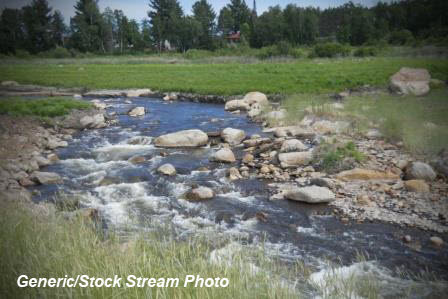
2.90 Miles
0 - 2.90
Cool-Cold Headwater, Coldwater
2025
Good
Sheboygan
Yes
Yes
No
Fish and Aquatic Life
Overview
Chambers Creek, in the North Branch Milwaukee River Watershed, is a 2.90 mile river that falls in Sheboygan County. This river is an outstanding/exceptional resource water under NR102 as well as a Class I Trout Water under the Fisheries Program. This river is managed for fishing and swimming and is currently not considered impaired.
Date 2011
Author Aquatic Biologist
Historical Description
Water Resources. Chambers Creek is the primary perennial stream in this subwatershed. It originates in a wetland
devloping its own channel, and receives discharge from one small perennial and one intermittent tributary.
Chambers Creek itself, discharges to the North Branch of the Milwaukee River at T13N R20E NENE Sec. 1.
Chambers Creek generally has good cover comprised of undercut banks and well established grassed banks. Water
clarity is generally good, with water temperatures and dissolved oxygen levels sufficient to support trout. It has minor
sedimentation and shallow pool depth in meanders and pools in the lower reaches. Bacterial contamination occurs at
CTH "W" generally during wet weather. Animal pasturing adjacent to the Creek appears to be a significant
contributor.
No toxic screening has been conducted on streams in this drainage system.
Fisheries. Chambers Creek supports a native population of brook trout. The unnamed perennial tributary also
providers consistantly cool water temperatures and high quality spawning areas. Dense shoreline vegetation and small
size limit, significant recreational opportunities along the unnamed tributary.
Date 1990
Author Surface Water Inventory Of Wisconsin
Condition
Wisconsin has over 84,000 miles of streams, 15,000 lakes and milllions of acres of wetlands. Assessing the condition of this vast amount of water is challenging. The state's water monitoring program uses a media-based, cross-program approach to analyze water condition. An updated monitoring strategy (2015-2020) is now available. Compliance with Clean Water Act fishable, swimmable standards are located in the Executive Summary of Water Condition in 2018. See also the 'monitoring and projects' tab.
Reports
Management Goals
Wisconsin's Water Quality Standards provide qualitative and quantitative goals for waters that are protective of Fishable, Swimmable conditions [Learn more]. Waters that do not meet water quality standards are considered impaired and restoration actions are planned and carried out until the water is once again fishable and swimmable
Management goals can include creation or implementation of a Total Maximum Daily Load analysis, a Nine Key Element Plan, or other restoration work, education and outreach and more. If specific recommendations exist for this water, they will be displayed below online.
Monitoring
Monitoring the condition of a river, stream, or lake includes gathering physical, chemical, biological, and habitat data. Comprehensive studies often gather all these parameters in great detail, while lighter assessment events will involve sampling physical, chemical and biological data such as macroinvertebrates. Aquatic macroinvertebrates and fish communities integrate watershed or catchment condition, providing great insight into overall ecosystem health. Chemical and habitat parameters tell researchers more about human induced problems including contaminated runoff, point source dischargers, or habitat issues that foster or limit the potential of aquatic communities to thrive in a given area. Wisconsin's Water Monitoring Strategy was recenty updated.
Grants and Management Projects
Monitoring Projects
| WBIC | Official Waterbody Name | Station ID | Station Name | Earliest Fieldwork Date | Latest Fieldwork Date | View Station | View Data |
|---|
| 32200 | Chambers Creek | 10008836 | Chambers Creek2 | | | Map | Data |
| 32200 | Chambers Creek | 10008779 | Chambers Creek #1 | 10/26/2000 | 10/17/2025 | Map | Data |
| 32200 | Chambers Creek | 10043575 | Chambers Creek 100M Downstream of HWY 28 | 1/1/2015 | 1/1/2015 | Map | Data |
|

Watershed Characteristics
Chambers Creek is located in the North Branch Milwaukee River watershed which is 149.67 mi². Land use in the watershed is primarily agricultural (45.40%), grassland (20.30%) and a mix of wetland (15.50%) and other uses (18.80%). This watershed has 159.81 stream miles, 886.38 lake acres and 13,793.69 wetland acres.
Nonpoint Source Characteristics
This watershed is ranked High for runoff impacts on streams, High for runoff impacts on lakes and High for runoff impacts on groundwater and therefore has an overall rank of High. This value can be used in ranking the watershed or individual waterbodies for grant funding under state and county programs.However, all waters are affected by diffuse pollutant sources regardless of initial water quality. Applications for specific runoff projects under state or county grant programs may be pursued. For more information, go to surface water program grants.
Chambers Creek is considered a Cool-Cold Headwater, Coldwater under the state's Natural Community Determinations.
Natural communities (stream and lake natural communities) represent model results and DNR staff valiation processes that confirm or update predicted conditions based on flow and temperature modeling from historic and current landscape features and related variables. Predicated flow and temperatures for waters are associated predicated fish assemblages (communities). Biologists evaluate the model results against current survey data to determine if the modeled results are corect and whether biological indicators show water quaity degradation. This analysis is a core component of the state's resource management framework. Wisconsin's Riverine Natural Communities.
Cool (Cold-Transition) Headwaters are small, usually perennial streams with cold to cool summer temperatures. Coldwater fishes are common to uncommon (<10 per 100 m), transitional fishes are abundant to common, and warm water fishes are uncommon to absent. Headwater species are abundant to common, mainstem species are common to absent, and river species are absent.